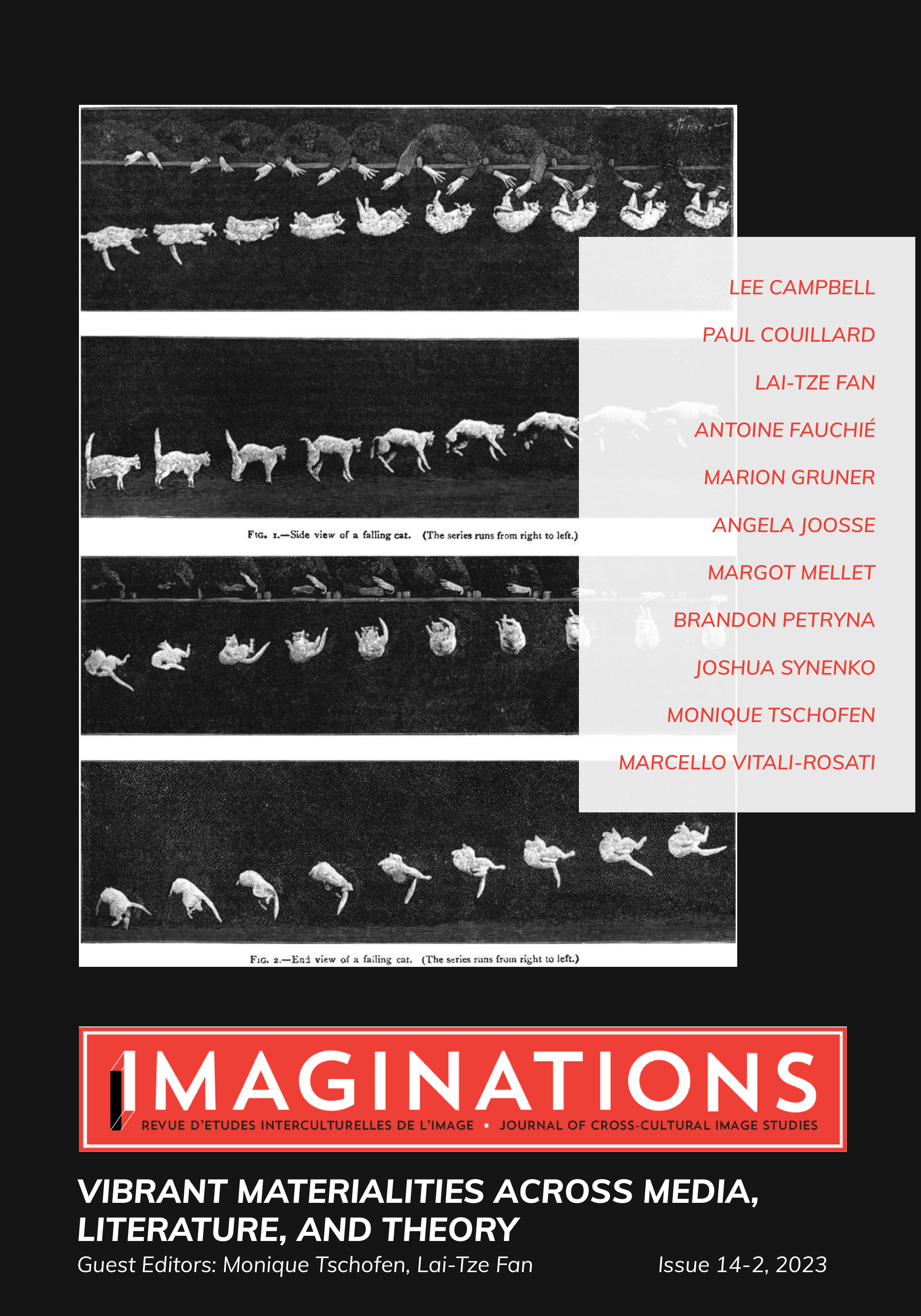Introduction: Vibrant Materialities Across Media, Literature, and Theory
DOI:
https://doi.org/10.17742/IMAGE29699Abstract
This special issue of *Imaginations: Journal of Cross-Cultural Image Studies* takes materiality as the critical touchstone for a new comparative literary and media studies. We ask: How can an examination of the modes of inscription across media, platforms, and interfaces draw greater attention to what is often ignored in critical conversations about texts, objects, and bodies; how can such an investigation attend to the vitality of their materiality? Studies of materiality may occur of/in: images, texts, subjects, and objects; philosophical approaches to materiality and interrelationality; cultural considerations of user relationships to media materiality; mediums of scholarship, including critical applications in open-source publishing; critical making and research-creation; and experiences, interactions, and representations of digital spaces. Here, we take materiality to include actants, actors, inscriptions, assemblages, interfaces, objects, bodies, things and the things we think with, as well as their agencies and provocations. The papers reconsider the entanglements between inscription and representation and between inscription and world through theoretical frameworks that show that “matter matters,” using approaches that include code studies, critical making, digital humanities, ecocriticism, feminism, Marxism, media archaeology, new materialism, and phenomenology.
References
Bennett, Jane. Vibrant Matter: A Political Ecology of Things. Duke University Press, 2009.
Bennett, Jane. “The Force of Things: Steps toward an Ecology of Matter.” Political Theory, vol. 32, no. 3, June 2004, pp. 347-72. DOI.org (Crossref), [https://doi.org/10.1177/0090591703260853].
Halberstam, (Jack). “Automating Gender: Postmodern Feminism in the Age of the Intelligent Machine.” Feminist Studies vol. 17, no. 3 (1991), pp. 439-460.
Haraway, Donna. “A Cyborg Manifesto: Science, Technology, and Socialist-Feminism in the Late Twentieth Century.” Simians, Cyborgs and Women: The Reinvention of Nature. Routledge, 1991.
Hayles, N. Katherine. “Print Is Flat, Code Is Deep: The Importance of Media-Specific Analysis.” Poetics Today, vol. 25, no. 1, Spring 2004, pp. 67-90.
Hayles, N. Katherine. How We Became Posthuman: Virtual Bodies in Cybernetics, Literature, and Informatics. University of Chicago Press, 1999.
Kirschenbaum, Matthew G. Mechanisms: New Media and the Forensic Imagination. MIT Press, 2008.
Montfort, Nick. “Continuous Paper: The Early Materiality and Workings of Electronic Literature.” 2004 MLA Convention. https://nickm.com/writing/essays/continuouspapermla.html Accessed 28 October 2023.
Puig de la Bellacasa, María. “‘Nothing comes without its world’: Thinking With Care.” The Sociological Review vol. 60, no. 2 (2012), pp. 197-216.
Resch, Gabby, et al. “Thinking as Handwork: Critical Making with Humanistic Concerns.” Making Things and Drawing Boundaries: Experiments in the Digital Humanities, edited by Jentery Sayers, University of Minnesota Press, 2017, pp. 149-61.
Springgay, Stephanie, and Zofia Zaliwska. “Diagrams and Cuts: A Materialist Approach to Research-Creation.” Cultural Studies ↔ Critical Methodologies, vol. 15, no. 2, Apr. 2015, pp. 136-44. https://doi.org/10.1177/1532708614562881.
Vitali-Rosati, Marcello. “Manifesto.” CCLA Literature and Media, https://ccla.digitaltextualities.ca/manifesto/. Accessed 28 Aug. 2023.
Wurth, Kiene Brillenburg. “The Material Turn in Comparative Literature: An Introduction.” Comparative Literature vol. 70, no. 3 (2018), pp. 247-263.
Published
How to Cite
Issue
Section
License
Copyright (c) 2023 Monique Tschofen, Lai-Tze Fan

This work is licensed under a Creative Commons Attribution-NonCommercial-NoDerivatives 4.0 International License.

This work by https://journals.library.ualberta.ca/imaginations is licensed under a Creative Commons 4.0 International License although certain works referenced herein may be separately licensed, or the author has exercised their right to fair dealing under the Canadian Copyright Act.




